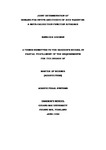Joint Determination of Demand for Inputs and Choice of Rice Varieties: A Meta-Production Function Approach
| dc.contributor.supervisor | Sriboonchitta, S | |
| dc.contributor.supervisor | Wiboonpongse, A | |
| dc.contributor.supervisor | Gypmantasiri, P | |
| dc.contributor.supervisor | Ekasingh, M | |
| dc.contributor.author | Rahman, Sanzidur | |
| dc.contributor.editor | Sriboonchitta S | |
| dc.contributor.editor | Wiboonpongse A | |
| dc.contributor.editor | Gypmantasiri P | |
| dc.contributor.editor | Ekasingh M | |
| dc.date.accessioned | 2016-09-10T15:45:44Z | |
| dc.date.available | 2016-09-10T15:45:44Z | |
| dc.date.issued | 1993-07-05 | |
| dc.date.submitted | 1993-06-07 | |
| dc.identifier.uri | http://hdl.handle.net/10026.1/5434 | |
| dc.description.abstract |
Fierce competition in the already thin world rice market for low quality rice exports raised concerns on the future of rice production in Thailand for its increasing labor wages and production costs and its exporting competitors' lower cost of production. Over the past decade, high growth rate was observed for planted area of Khao Dawk Mali with fluctuating production and yield in northern Thailand. Khao Dawk Mali can be conceived as an alternative crop as Thailand enjoys a duopolistic competition in high quality rice market. Joint determination of farmers' responses to variable input price changes and rice variety choice at the farm-level would assist in exploring the potential of Khao Dawk Mali expansion as well as for predicting the impact of alternative policy instruments to assist the rice production sector. Ignoring the possibility of seed variety switching leads to underestimates of input demand elasticities. In addition, estimation with samples reflecting a single rice variety may involve serious selection bias. As such, a Two-Stage Switching Regression procedure which adjusts for selectivity bias is used to estimate the normalized restricted translog profit function model. The plot-level crop production data for the wet season, crop year 1992, were collected from six districts (amphoe) of Chiang Mai Province. Estimated results for the elasticities of probability of planting Khao Dawk Mali from the first stage probit model revealed that seed selection is quite responsive to the fertilizer/rice price ratio as expected. The elasticity of probability with respect to land area suggests that land is positively related with Khao Dawk Mali adoption. The second stage estimation of the normalized restricted translog profit function jointly estimated with three factor share equations using Seemingly Unrelated Regression Estimator method revealed that there was significant selectivity bias in estimating equations from a subsample of cultivators in Khao Dawk Mali regime, hence supporting the hypothesis of the study. All own-price elasticities were inelastic and the inputs were complements. The total own-price elasticity of demand after allowing for the seed switching adjustments for fertilizer, labor and tractor power were estimated at -0.81, -0.69 and -0.37, respectively. The impact of seed switching adjustments were about 9, 40 and 17 percent for fertilizer, labor and tractor power respectively. The output supply elasticity was estimated at 0.31. The output supply with respect to farm area and value of fixed farm assets were estimated at 0.90 and 0.04, respectively. A 10 percent reduction in tractor power price is suggested from the ranking of fifteen policy alternatives according to their cost-effectiveness for Chiang Mai province, that would yield a net benefit of 26 baht/rai to rice farmers and a net return of 18.7 percent to the country. On the other hand, a rice (output) price subsidy of 10 percent would yield substantially higher net benefit of 274 baht/rai to farmers and a net return of 16.7 percent to the country (ranked two). For the combined policy alternatives, tractor power and rice subsidy would yield a net benefit of 300 baht/rai to farmers and a net return of 16.2 percent to the country (ranked three). Therefore, in order to increase rice production and raise farm income for Chiang Mai province, policy makers should focus on rice prices and tractor power prices. | |
| dc.language.iso | en | |
| dc.title | Joint Determination of Demand for Inputs and Choice of Rice Varieties: A Meta-Production Function Approach | |
| dc.type | thesis-dissertation | |
| plymouth.publisher-url | http://www.chiangmai.ac.th/ | |
| plymouth.conference-name | Chiang Mai University | |
| plymouth.organisational-group | /Plymouth | |
| plymouth.organisational-group | /Plymouth/Faculty of Arts, Humanities and Business | |
| plymouth.organisational-group | /Plymouth/Users by role | |
| rioxxterms.licenseref.uri | http://www.rioxx.net/licenses/all-rights-reserved | |
| rioxxterms.type | Thesis |


